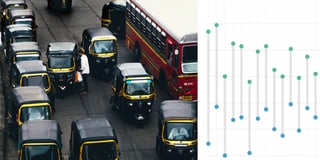The glaciers are melting. Are ski resorts digging their own graves?
Hi, I’m Jack, a developer from Datawrapper's app team. Today, we’re looking into the climate impact of skiing trips.
Having had the incredible privilege of growing up in a ski resort in the French Alps, it’s no secret to me that skiing trips are far from being an eco-friendly activity. Which is ironic considering that skiing, and winter sports in general, are some of the first leisure activities to be threatened by the effects of climate change.
This contradiction is not lost on me. Throughout my life, I saw and continue to see my local glacier, La Grande-Motte, retreat at an accelerating pace up the mountain year after year.
According to a study by the Institute of Geosciences of the Environment (IGE) in Grenoble, the glacier had shrunk by a third in surface area and over two thirds in volume between 1982 and 2019, and is expected to be mostly gone by 2057.
The snow melt has accelerated so much in the last 20 years that a new lake formed at the base of the glacier, which had to be artificially drained to mitigate the risk of flooding the village below.
Given that my home town’s economy relies so heavily on both tourism and a stable climate, I wanted to take a deeper look into how incompatible these goals are and what can be done to reduce the emissions of skiing trips.
According to a study by UTOPIES, a typical ski trip to my home town of Tignes emits 48.9kg of CO2 per day. And over half of the emissions come from travel to and from the destination.
This, of course, is based on an average trip. The exact carbon footprint of your skiing adventure depends heavily on the type of transport used.
The 48.9 kg CO2e per ski-day is roughly in line with, if slightly higher than, the 44 kg CO2e average per person per night for domestic tourism in France.
Though with a record 75% of Tignes’ seasonal visitors coming from abroad in 2024, the true average emissions are likely much higher than the study by UTOPIES estimates, which took the average data across Tignes and two other resorts, Le Grand Bornand and La Clusaz, in 2021. Especially with a growing number of tourists coming from North America and Poland.
It should also be noted that ski trips will usually last longer than a city break because of the remoteness of the destinations, which has the impact of “diluting” the high CO2 cost of the transport over more days, thus lowering the per day average.
Different destinations, similar impact
Before looking into the data surrounding this topic, I would have assumed that maintenance of the resort, like snow cannons, groomers, and ski lifts, would contribute a lot more to the total emissions of a trip to the mountains. I also expected the heating of accommodation, as well as the cheese and meat-heavy diets in the Alps, to be more impactful.
What I learned is that while skiing isn’t exactly eco-friendly, it also isn’t significantly worse than any other vacation activity in itself. The distance travelled and method of transport used to get to the destination have far more impact than the activities done once there.
What can be done?
It would seem that the most significant option to limit the climate impact of your holiday, no matter where you’re going, is to stay close to home and prioritise travelling by train or by bus.
Beyond the individual choices we can make to reduce our own footprint, there are wider socioeconomic factors that play into the high emissions of tourism, and particularly skiing vacations. It’s no secret that skiing is an expensive hobby and is rapidly getting more so, as low altitude resorts close down because of a lack of snow and financial difficulties. This has the effect of reducing local supply and concentrating 81% of attendance to the big-name, high altitude, more remote and difficult-to-get-to resorts — thus increasing transportation related emissions.
Between rising ski pass and accommodation prices, the high cost of equipment, as well as falling buying power among the majority of the population, skiing is becoming a luxury for an even smaller elite than before. 17% of high-income individuals go on holiday to the mountains every winter in France, versus only 6% of low-income earners, according to the Obervatory of Inequalities.
The habits of higher income individuals tend to have a much higher environmental impact than the rest of the population. In fact, the 10% highest earners emit close to 50% of total emissions. So a more systemic approach to reducing the average emissions of the ski industry would be to make resorts more accessible, both physically and economically, and to address the roots of wealth inequality along with emissions associated with the lifestyles of the rich.
That’s it for this time! Check in next week for another Weekly Chart from our head of design, David.



